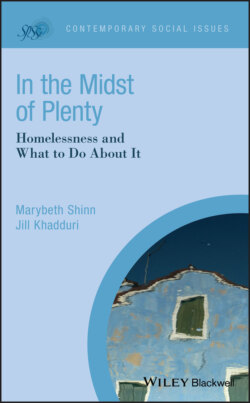Читать книгу In the Midst of Plenty - Marybeth Shinn - Страница 16
Adults on Their Own
ОглавлениеNationally, almost two‐thirds (65%) of people who use shelters at some time over the course of a year are individuals—that is, adults without children with them. Similarly, 67% of people homeless on a particular night are individuals, but this includes unsheltered people, 90% of whom are not part of a family with children. Only 54% of those using shelters on a particular night are individuals (Henry, Bishop, et al., 2018; Henry, Mahathey, et al., 2018).
Most of those considered individuals are by themselves—less than 3% of those who use shelters do so together with another adult. Again, this is partly, although certainly not entirely, a consequence of shelter policies. We have already noted that men may be excluded from family shelters, and there are relatively few locales where childless couples or childless families with other configurations can be accommodated together. In Nashville's 2019 PIT count, for example, over 30% of the 236 unsheltered people interviewed reported that they were homeless with someone else on the night of the count—half with a spouse or partner and the remainder with other relatives, including adult children, and friends (Bernard, 2019). The ability to live with a loved one, or even a beloved pet, is a reason some people stay on the streets.
The national data show that individuals use shelters for only short periods of time, a median of 22 nights over the most recent 1‐year period (Henry, Bishop, et al., 2018). Often, those 22 nights are not continuous but instead are interspersed with periods when the individual is housed (perhaps precariously) or is sleeping rough. Most individuals who use shelters do so only once, and relatively briefly, with brevity often depending on the shelter policies of the jurisdiction where they experience homelessness.
By analyzing shelter records, Culhane and colleagues showed that four‐fifths of individual adults who entered shelters in Philadelphia and New York City stayed briefly (an average of 20 days in Philadelphia and 57 in New York), and most did not return during the 2‐ or 3‐year follow‐up period. The authors dubbed this pattern transitional. The rest were almost evenly divided among people who shuttled in and out of short stays in shelter and a second group with fewer, but longer, episodes. By self‐report and administrative records, the latter two groups had more medical and behavioral health problems (Kuhn & Culhane, 1998).10 This study was groundbreaking in its demonstration that so many individuals experience homelessness in single, brief episodes. Homelessness is not a permanent trait, but a temporary state that most people pass through before returning to housing (Shinn, 1997).
